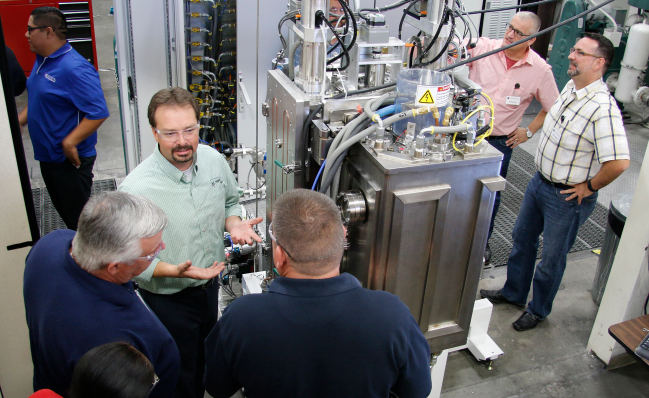
Vapor Technologies Inc.
Vapor Technologies, Inc.’s VaporTech® physical vapor deposition (PVD) coating machines offer many advantages to consumer and industrial product manufacturers. “PVD coatings have characteristics that are ideal for many applications,” says David Wayne, sales and marketing director for the Longmont, Colo.-based capital equipment manufacturer. “We help our customers improve the appearance and function of their products through the use of thin-film coatings.”
The PVD process involves evaporating a metal under vacuum and condensing it into a solid, thin-film coating on the surface of a metal or plated part. “The difference between this and other finishing methods is that, with paint and powder coating, you’re applying a relatively soft organic-based material on a surface,” Wayne says. “With PVD finishes we are taking a solid material such as a metal, vaporizing it in a vacuum, combining it with other elements to customize its physical properties, and then condensing it on the surface of a product.”
PVD coating can improve not only the color and appearance of a part but also its physical properties. “We can make a surface electrically conductive or electrically insulating, as well as more wear-resistant or scratch-resistant,” adds VaporTech global applications engineer Nick Peterson. “We can also make a surface more corrosion resistant or even reduce the coefficient of friction.”
VaporTech finishing equipment also enhances manufacturers’ overall operations. “There are typically a few reasons companies choose to bring PVD coating technology in-house rather than outsourcing their finishing, one of which involves supply chain issues,” Wayne says. “Manufacturing a part, packing and shipping it for finishing, then receiving and packaging it again for the end user can create disruptions to a manufacturing process. VaporInfo
“If I send out a part and it takes several weeks for shipping and finishing, that adds to my production time,” he adds. “With in-house finishing operations, this finishing time can be reduced from weeks to hours. The ability to make products more quickly and reduce work-in-process inventory is one of the biggest reasons for bringing this and other finishing technologies in-house.”
 In-house finishing technologies also allow manufacturers to control costs better and keep a closer eye on quality. “In most cases, finishing a part internally can be significantly less expensive than finishing it elsewhere,” Wayne says.
In-house finishing technologies also allow manufacturers to control costs better and keep a closer eye on quality. “In most cases, finishing a part internally can be significantly less expensive than finishing it elsewhere,” Wayne says.
Meeting Specifications
VaporTech works closely with its customers to customize a finish that matches their specific part requirements. “We work with manufacturers to identify the characteristics they want to improve, develop a coating, deliver a coating system, and help them integrate these new processes into their manufacturing operations,” Peterson says.
The VaporTech line of coating systems are available in a range of sizes and throughputs to match customers’ needs. Each system can also be configured to apply different finishes by adjusting process recipes or by easily changing out the source materials – such as chromium, titanium, or zirconium – being used in the process.
VaporTech units are batch systems. Operators load parts into a vacuum chamber, and the chamber pumps down to very low pressure. The system applies energy to the source material being used in the coating. The material is vaporized, combined with other elements such as nitrogen, oxygen, or carbon to customize the coating characteristics or color, and finally condensed onto the surface of the parts.
VaporTech systems can also be configured to apply diamond-like carbon (DLC) finishes to products through the process of plasma enhanced chemical vapor deposition (PE-CVD), which uses a similar process to PVD but uses a carbon-containing gas rather than a metal as the coating material. DLC finishes can improve both the functional and aesthetic properties of the part.
Broad Applications
A variety of different industries use VaporTech coating systems. These industries include home hardware, consumer goods, consumer electronics, sporting goods, transportation, energy, medical devices, and industrial tooling. “This technology is applied to a broad range of products that we as consumers use every day,” Wayne says.
Products with PVD and DLC finishes fall into two main categories. The first of these is durable-decorative applications, which include products ranging from bath and kitchen hardware to trim pieces on cars and motorcycles. A broad range of consumer goods such as watches, sporting goods, golf products and firearms can also benefit from durable decorative PVD finishes.
Functional coating applications are the company’s second main product category. This category includes parts that are typically not consumer-facing, but which still require durability or special characteristics, such as engine components, medical devices such as joint replacements, and cutting tools.
A Global Reach
Though Vapor Technologies has offered PVD coating systems for more than 20 years, the use of PVD is now expanding into many new industries and applications. “This is a new technology for a some of our customers, so our technical and applications group works closely with each customer to help them understand the coating process, equipment, and ways to simplify implementation,” Wayne says.
The company has extensive technical and other resources available to it because of its status as a subsidiary of Masco Corporation, a publicly traded Fortune 500 home improvement and building product manufacturer. “Our business is focused on finishing equipment, but being a part of Masco gives us good financial backing and a global reach compared to many of our smaller, start-up competitors,” he adds.